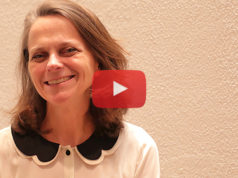
The study data were delivered in two presentations at VEITHsymposium (13–17 November, New York, USA) by Mark Adelman (NYU Langone Hosptial, New York, USA) and Kathleen Gibson (Lake Washington Vascular Surgeons, Bellevue, USA).
They explained that incompetent perforator veins are associated with the development of venous ulcers. While endovascular ablation has demonstrated good technical success and a low complication rate, most studies have focused on successful ablation of the vein rather than venous ulcer healing, and very few studies have investigated the effectiveness of perforator vein ablation in patients with venous ulcers.
The purpose of the SeCure study was to see if the laser device would act equally or better than radiofrequency devices recorded in the literature. The study is a single arm, prospective, multicentre, non-blinded trial with an intent-to-treat population of 83 patients (125 perforator veins). It enrolled patients with CEAP class 4b, 5 and 6 attributable to the incompetent perforator vein, as long as the saphenous trunks were either normal or previously treated. Multiple incompetent perforator veins in one limb could be treated, but only one limb of each patient was permitted study treatment.
The primary objective was ablation of incompetent perforator veins with a performance goal of 75%. Secondary endpoints were procedural technical success rate (successful access and entry into the incompetent perforator veins to be ablated and the ability to deliver the intended laser energy); one, three, nine and 12-month primary ablation closure rates; and changes in Venous Clinical Severity Score (VCSS), CEAP symptoms, quality of life from baseline and procedure-related adverse events.
Pathologic incompetent perforating veins are defined as those with outward flow of >500msec, a diameter of >3.5mm, and located beneath a healed or open venous ulceration.
Adelman explained that approximately two-thirds of limbs with skin changes have incompetent perforator veins as well as superficial or deep venous reflux, and that 63% of recurrent varicose veins are associated with incompetent perforator veins. Further, the Society for Vascular Surgery (SVS) and American Venous Forum (AVF) recommend the treatment of perforator veins with reflux >500ms and a vein diameter >3.5mm.
Describing the procedure, Gibson tells Venous News, “The treatment is performed with a 400 micron laser fibre that can be placed either through a micropuncture needle or catheter. Local anaesthetic is administered around the laser fibre tip prior to activation.”
Results
The initial technical success performance goal, in other words the ability to deliver the laser energy to the perforator vein, was set at 75% for the trial, but the study result was in fact 95.2% (p<0.001), Adelman reported. Further, the 10-day ultrasound data for the closure rate surpassed the performance goal (based on radiofrequency ablation literature) of 70% and was 76.8% in the study.
As for the reintervention rate, Adelman explained that there were very few reinterventions in the first six months and only one attempted reintervention that failed. However, at the nine and 12 month intervals, four out five reinterventions, and five out of eight were retreated successfully, respectively. Methods of retreatment were direct ligation, foam sclerotherapy and laser retreatment.
Adverse events at three months were measured in 83 patients: deep vein thrombosis (2), vein thrombosis (1), superficial thrombophlebitis (1), skin ulcer (4), entry site wound (1), procedural pain (1).
Following the presentation of results by Adelman, Kathleen Gibson took to the podium to discuss the changes in VCSS, quality of life and ulcer healing.
Gibson reported that there was a statistically significant improvement in VCSS from mean of 12.4 at baseline to 8.7 at 12-month follow-up. Similarly, at each follow-up timepoint, the VEINES and VAS scores improved from baseline (VEINES = mean 45.2 at baseline to 51 at 12-month follow-up; VAS = mean 23.4 at baseline to 14.7 at 12-month follow-up).
In terms of ulcer healing, Gibson showed that 23% of the patients had ulcers on entry into the study, which declined to as low as 8.5% at six months follow-up and was recorded at 12.8% at the 12-month follow-up. Further, wound healing also saw an improvement from baseline with median 3.8cm2 recorded at screening to 2.6cm2 at 12 months follow-up.
Adelman concluded that while this is a somewhat challenging procedure, in his experience, the use of laser is easier than radiofrequency because the access is smaller and it is therefore easier to get into the perforator veins. “The SVS and AVF are already recommending treatment for C5 and C6 disease, and this trial includes C4b as well. It found that 400µm optical fibre with the 1470nm laser had a superior closure rate to radiofrequency and led to the FDA clearance of 400µm optical fibre for the treatment of incompetent perforator veins,” Adelman added.
Gibson added, “the SeCure trial showed that the laser could be used as a safe and effective treatment for treating incompetent perforator veins, and there was significant improvement in patient quality of life, with increased ulcer healing and decreased wound size.”
Watch the video interview with Kathleen Gibson on the SeCure trial results here










